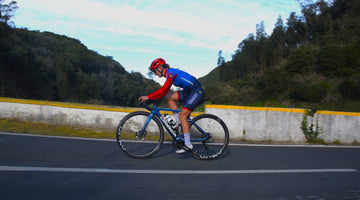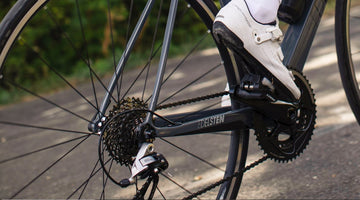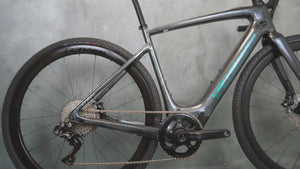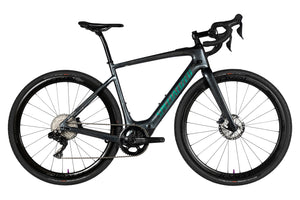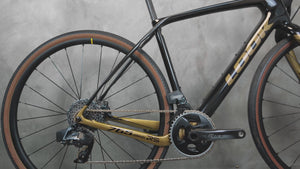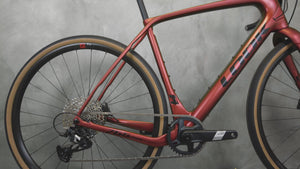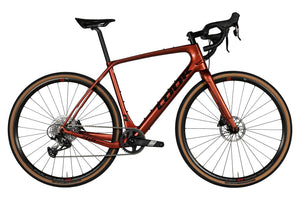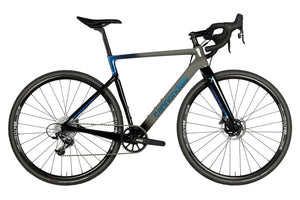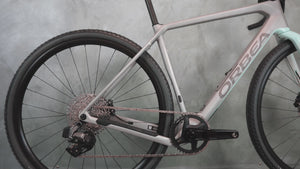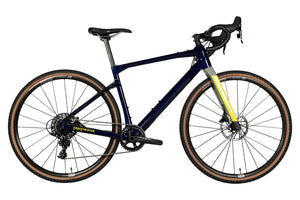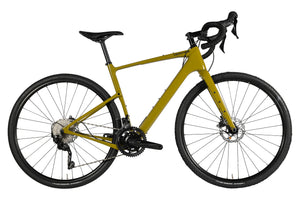Transmission for gravel bikes : single vs. double tray
In this Article
Published on September 20, 2021 (updated on May 16, 2022)
Thanks to its versatility, the gravel bike has been a great success in recent years. It is halfway between the road bike and the mountain bike which allows him to adapt to many situations and therefore to many people. This is what makes him so popular today!
Almost all bike manufacturers have launched into the gravel: Specialized, Cannondale, BMC, Cervélo just to mention a few. This is good news for you because it allows you to have a very wide choice when building the bike of your dreams.
But here you are, putting together your future touring companion, choosing all the parts to make it perfect in your eyes, and then comes the time to ask yourself THE question: how to choose between a single chainring (x1) or double chainring (x2) drivetrain ?
To choose the transmission that suits you, you must first of all,know your physical condition and have an idea of the type of terrain you want to ride on.
Then you need to know what kind of terrain you want to ride on, The Cyclist House, the Certified Pre-Owned bike specialist, will help you weigh up the pros and cons of single and double-deck transmissions. Our experts break down for you all their fundamental differences (quantitative and qualitative). So if you are still hesitating between a single or double chainring, this article will help you make a choice!
Estimate the number of gears needed for each gravel practice
When it comes to the number of gears on your bike, you need to consider the length and steepness of the hills you're climbing, as well as the speed at which you intend to ride them (and descend them).
The first thing to consider is the development range: how much difference do you have between your hardest gear and your easiest gear? When it comes to modern transmissions, dual chainrings usually win this debate.
In SRAM's Force AXS drivetrain family, the easiest single chainring is 36 teeth and the hardest is 48 teeth. Combined with a Cassette of 10-36 teeth, a single chainring naturally does not offer the development range of a 46/33 or 48/35 tooth Force AXS crankset on the same Cassette. You encounter the same limitation with the Shimano GRX, which only offers a single chainring with 40 or 42 teeth. It can't compete with a 48/31 teeth double crankset on a Cassette standard 11-32 teeth.

Fortunately, you can get a gear range close to that of a double chainring setup by using a Cassette larger chainring. With SRAM components, you can opt for a Force 1 mechanical transmission that uses a Cassette from 10 to 42 teeth. For an even wider range, you can also use a mountain bike rear derailleur Eagle AXS with a Cassette 10-50 teeth and AXS Force shifters - colloquially known as a "mullet" transmission. Shimano also offers a Cassette XT with 11-42 teeth that could work with a GRX derailleur.
These wide-range cassettes all have one drawback. They have wider gaps between gears. When you shift from one gear to another, you won't always be able to maintain the ideal cadence and effort level, depending on the terrain.
As you might expect, a SRAM AXS mullet drivetrain will be heavier in the Cassette and rear derailleur - 352 and 354 grams, respectively - compared to Force AXS, which weighs 309 grams for a Cassette of 10-36 teeth and 326 grams for the rear derailleur. However, when comparing the mullet to a dual chainring configuration on the Force AXS, this 71 gram difference is offset by the weight of the front derailleur alone.
And since we're talking about transmission here, you might be wondering about the benefit of a electric vs. mechanical drivetrain. Find out the pros and cons in our article dedicated to this topic.
Compare the weight of the 2 options
As for the road bike, the mountain bike or cyclocross, the models of gravel bikes are the most popular.
As you might expect, a single-drivetrain bike with fewer components is bound to be lighter than a dual-drivetrain bike. But how much lighter?
In the case of SRAM's Force AXS drivetrain, the front derailleur weighs about 200 grams, and a double chainring crankset weighs about 46 grams more than a single chainring crankset. Shimano's gravel-specific GRX groupset also offers both options. Its double chainring crankset is 55-66 grams lighter than its SRAM equivalent, and its non-electronic front derailleur weighs 96 grams. A GRX Di2 electronic front derailleur weighs 135 grams. So, in the worst case, a double chainring configuration adds 246 grams.
Are you worried about the extra 200 to 250 grams of weight? That's up to you. If you're wondering what 200 grams equals in real life, a 600 mL bottle of water weighs about 650 grams.
Simplicity vs. complexity
Even for a dual chainring enthusiast, there is a certain elegance to a single chainring bike. SRAM fought to get rid of the front derailleur, especially on mountain bikes, and others followed suit: they did the same for cyclocross and gravel bikes.
Without a front derailleur, the shifting logic becomes simpler. This is good for new riders who don't have the experience to know when you should (or shouldn't) shift with your front derailleur. Plus, without a front derailleur, you have one less piece of wear and tear, one less adjustment to make when tuning a bike, and one less thing that can go wrong when you're out in the wild. And that's not insignificant!
In terms of maintenance, we can also say that the wear of the chainrings is divided between two chainrings on a double drivetrain, which makes the problem half as worrying as on a single chainring.

To each cyclist his preference
As mentioned above, SRAM has done away with front derailleurs on new mountain bikes. Shimano has done the same. On the road, however, we still see a lot of bikes with double chainring transmissions.
The great thing about gravel is that it's a meeting place for mountain bikers and road riders. Through the choice of gearing you can tell which type of cycling the person sharing your ride is from. For example: a single wheel gravel bike will be more familiar to a mountain biker. Many of you have written to us asking about the benefits of buying a gravel bike vs. a semi-rigid mountain bike - read our opinion on the question in this article.
Chain safety
When it comes to current groupsets such as SRAM AXS or Shimano GRX, it's a given that they all have clutch rear derailleurs. The clutch mechanism keeps the derailleur cage tight, which prevents chain slap on rough roads. It also reduces the risk of dropping the chain = no more being the one you're waiting for because he/she has to put the chain back on during your rides!
It is important to note that previous generations of drivetrains are not always equipped with clutch derailleurs. There are used gravel bikes equipped with Shimano 105, Ultegra or Dura-Ace, or others equipped with SRAM Rival, Force or Red.
With one of these drivetrains, you won't have as much chain security. In this case, your best option might be the SRAM Force 1, a single chain group that has been around for many years and has always used a clutch rear derailleur. It also has a narrow/wider chainring, which is designed to hold the chain. Dual cranksets use chainrings designed to facilitate shifting with pins and ramps, which is not really conducive to chain safety.
If you ride on dirt roads, this may not be a problem. But if you're more adventurous and often find yourself on bumpier forest roads, a clutch derailleur might be a good and much more reliable option.
Because let's be honest, we've all had a problem with our front derailleur. The single chainring allows to gain in reliability because there is no possible derailment before tackling an unexpected climb or because of a too soft and muddy terrain. It has become almost indispensable for mountain bikes and gravel bikes.
Conclusion
The simplicity of the single chainring is unbeatable, there is no more front derailleur. On the other hand, in order to maintain a wide gear range with a single crankset, there will be bigger jumps between the rear shifts.
Our opinion at The Cyclist HouseOne of the reasons the 1x single chainring makes more sense for off-road riding is that you'll be less bothered by differences in cadence when changing gears and you'll get a little more tire clearance. On a smoother, well-groomed surface, you may have a hard time finding the gear that's best for you.
The 2x chainring is best if you are riding on a variety of roads, especially on well-maintained tarmac. Personally, I always ride on mixed surfaces, so the 2x is best for me.
Continuing with the great philosophical questions of bike enthusiasts, check out our articles : carbon fiber frame vs. aluminum, how much to spend on your first bikeor even, disc brake or shoe brake : which one to choose ?





















